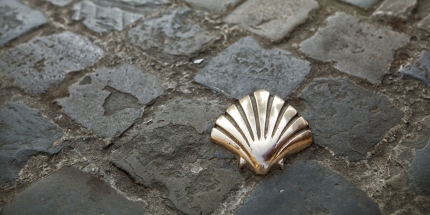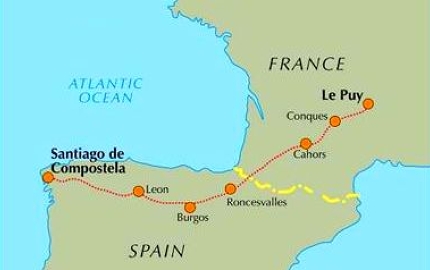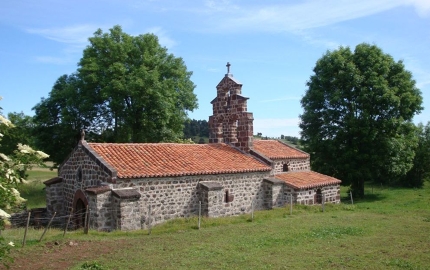Unlocking the secrets of St James's Way

A scallop shell guides pilgrims along the Way of St James
artJazz / Thinkstock
From headless saints to homicidal poets, David Middleton unlocks the secrets of St James's Way, Europe's most famous pilgrimage route.
Man-eating beasts. Plague. Murder. Suddenly I was happy to accept the priest’s blessing before setting off along Le Chemin de Saint Jacques de Compostela or the Way of St James.
He’d offered it at the 7am mass in the cathedral of Notre Dame du Puy, high in the French Auvergne. The service had attracted a mixed bunch of travellers; rucksacks and canes were propped up in the pews. It looked like a holy waiting room, expecting the arrival of the 7.32am to Heaven.
For me, however, the journey was less spiritual and more a quest to discover the myths and legends of this famous pilgrimage. As we gathered under the statue of St James himself, a smiling nun pressed a small medallion into my hand bearing the image of the Black Madonna, patron saint of the cathedral. On the reverse was a scallop shell, the symbol of St James.
According to legend, St James was beheaded in 44AD for spreading the gospel in Spain. His remains ended up in the northern Spanish town of Santiago where a cathedral was erected. Subsequently it became a place of pilgrimage. Scattered along the coast, the scallop shell was collected as evidence that pilgrims had visited the saint’s resting place.
Top Photo Corporation / Thinkstock
From Le Puy to Santiago, a gruelling distance of 1,600km (994 miles), the shell symbol manifests itself in stone reliefs and wooden carvings, in shrines or dangling from the necks of pilgrims. As I descended the steps of the cathedral onto the steep and cobbled rue des Tables, I pocketed my medallion, tightened my rucksack and followed the scallop trail towards my own destination, Nasbinals, five days and 120km (75 miles) away.
For fans of geological phenomena, Le Puy-en-Velay is dotted with extinct volcanic plugs. But instead of spurting magma, they support religious edifices like the Cathedral of Notre Dame, an enormous statue of the Virgin Mary, the cloister of St Michael and the statue of St Joseph. Walking through the town you get the impression that the gods of Mount Olympus would be equally at home here if they were ever displaced.
Headless saints aside, the route has attracted its share of colourful characters, and leaving the town I was soon on isolated forest trails where early pilgrims would have been at risk from thieves.
One such vagabond is alleged to have been Francois Villon, a 15th-century poet and an intellectual who, after being involved in a priest’s murder, was banished from Paris. Destitute, he described himself as “a hungry wolf, driven by hunger from his lair”.
Turning to armed robbery he went south, joining newly unemployed young men, demobbed and homeless after the end of the 100 Years’ War. As part of a quasi-military organisation known as the Coquillards, they posed as pilgrims from Santiago de Compostela, mingling with their victims wearing the coquille (the scallop shell around their necks) and robbing them along the route.
 The 1,600km route between Le Puy and Santiago
The 1,600km route between Le Puy and SantiagoSaint James's Way
Hence the pilgrims were grateful for any sanctuary along the way, with hamlets such as Montbonnet offering shelter and a Christian welcome. Here, the small Chapel of Saint Roch is dedicated to the patron saint of pilgrims, who contracted the plague after healing the sick on his way to Santiago.
Thankfully Villon was nowhere in sight as I quickened my pace through thick pine forests and steep gorges, surfacing in villages like St Privat d’Allier and Monistrol d’Allier, firmly on the pilgrims’ route with their friendly gites d’étapes (stopover shelters). One of the most memorable, the Domaine du Sauvage, an isolated and fortified gite associated with the Knights Templar, lies just beyond the town of Saugues.
After kicking off my boots here and taking a hot shower, I joined a happy band of pilgrims for dinner. Many were travelling in small groups taking in sections of the route or journeying alone to Santiago. Their devotion to the cause was clear, and their irreverent humour and anecdotes helped to melt the ice.
I heard about the Beast of Gevaudan, a wolf-like creature that, between 1764 and 1767, was said to have devoured 100 women and children. The King’s army was drafted in to track it down but it was finally killed by a lone huntsman who took it to Versailles to prove he had despatched it. Unfortunately, his trek through the hot summer months left him with a completely rotten corpse and few believed his heroic tale.
At this point I expected someone to utter ‘Beware the moon!’ but most pilgrims had slipped away, either in fear or the prospect of an early breakfast. After an appropriately atmospheric night of howling winds and thunder and lightning, I took up my rucksack once again.
 The quaint Chapelle St Roch along St James's Way
The quaint Chapelle St Roch along St James's WayDavid Middleton
Several kilometres and many pilgrim re-acquaintances later, the terrain changed from sheltered forest and fertile fields to the exposed Aubrac plateau. Scattered across the harsh moors are massive granite boulders, left behind by glacial activity. High on the plateau, the Roche des Loup or Wolf Rock is split asunder and would be the perfect setting for a biblical epic.
Remote, some might say godforsaken farmsteads, such as Le Moulin de la Folle or the Mill of the Crazy Woman, give a slight clue as to how your wits could be tested in such a windswept and unforgiving landscape. Luckily this is now a gite and a welcome resting place with no wild women in sight.
My descent from the plateau ended very cheerfully in the village of Nasbinals and, having dealt with the challenges in reality and myth, I think John Bunyan himself would have been proud of my progress. Santiago, though, seemed a very long way off.
NEED TO KNOW
Getting there
Direct Flights from thUK to Lyon St Exupery from Gatwick and Stanstead start at around £72 at the beginning of September with easyJet. Birmingham starts at around £120 with Flybe and Air France.
When to go
Late spring and early autumn are good times to take the trail in order to avoid busy school holiday periods and with less extreme temperatures.
Find out more
The Way of St James has four principal routes in France: Paris, Vézelay, Le Puy and Arles. For more information visit www.santiago-compostela.net.
Related articles
The 10 best pilgrimages for modern travellers
Top 5 religious sites
Do you have any Feedback about this page?
© 2025 Columbus Travel Media Ltd. All rights reserved. No part of this site may be reproduced without our written permission, click here for information on Columbus Content Solutions.









 You know where
You know where